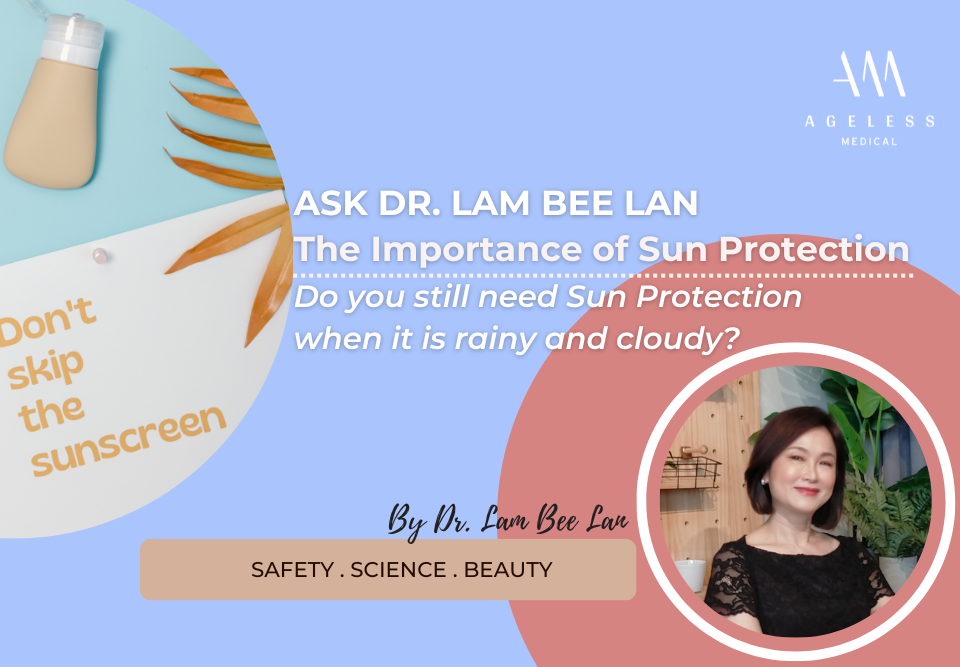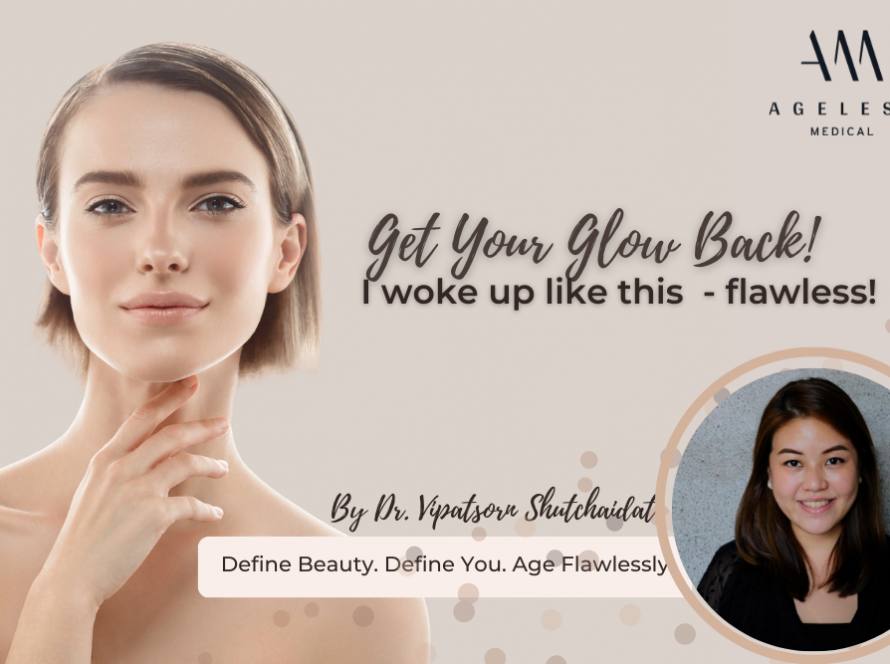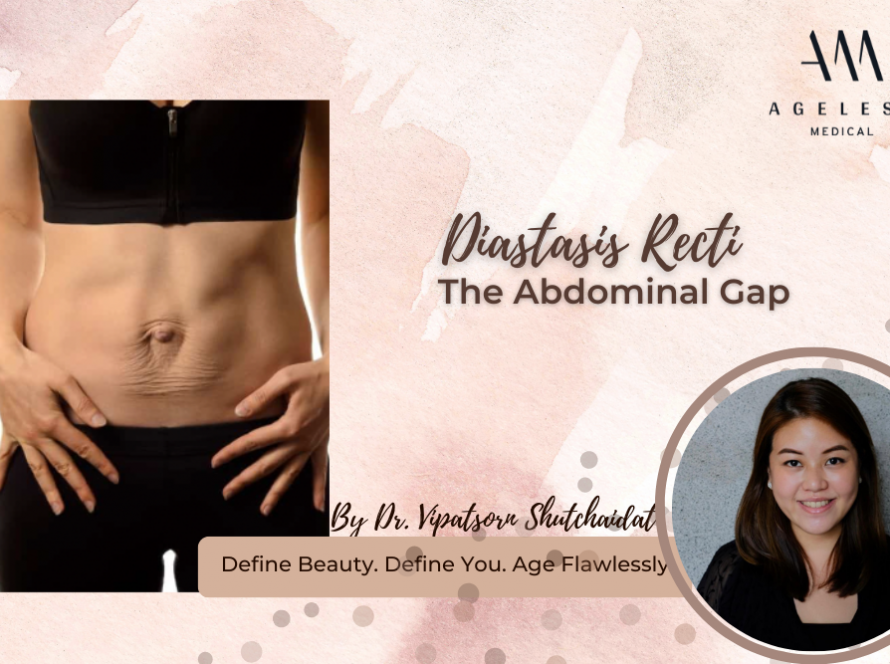Ask Dr Lam Bee Lan – The Importance of Sun Protection
Do you still need Sun Protection when it’s Rainy and Cloudy?

We’ve been told sun protection is important for skin health, and even preventing skin cancer, but do you still need it when it’s cloudy and rainy? Let Dr. Lam Bee Lan explains the importance of sun protection and the different sunblocks options.
Q: Why are we so concerned over sun protection?
A: The sun gives off rays of light that can help and harm us. We know that a small amount of sunlight is important for the production of Vitamin D in our skin. Vitamin D3 is important for the absorption of Calcium. Our body needs calcium to build and maintain healthy bones.
The sun rays or radiant energy consist of:
- 3-7% long wave ultraviolet A (UVA) and short wave ultraviolet B (UVB) and UVC
- 44% High Energy Visible Light or Blue Light
- 53% Infrared radiation.
Infrared radiation (IR), or infrared light, is a type of radiant energy that’s invisible to human eyes but that we can feel as heat. All objects in the universe emit some level of IR radiation, but two of the most obvious sources are the sun and fire.

Ozone in earths atmosphere absorbs 100% of UVC, approximately 90% of UVB and virtually no UVA and hence depletion of ozone layer has lead a substantial increase in ultraviolet radiation transmission to earths surface.
UVB is shield off by glass panels, but UVA rays pass through glass and penetrate deeper into the dermis, the skin’s thickest layer.
UVA can lead to premature skin aging, pigmentation and wrinkling (photo-aging), and some types of skin cancers. UVB rays will usually burn the superficial layers of your skin. It causes premature skin ageing and plays a key role in the development of most skin cancer.
We can reduce the risk of premature skin ageing and skin cancers by protecting the skin against UV rays through topical sunblock and oral antioxidants that can fight free radicals.
Regulated sun exposure is beneficial to human beings because it prevents autoimmune diseases, helps to produce Vitamin D3, is beneficial in many skin diseases like psoriasis, vitiligo and increases the serum levels of endorphins.
The production of vitamin D, a vitamin essential to human health. Vitamin D helps the body absorb calcium and phosphorus from food and assists bone development. The World Health Organization (WHO) recommends 5 to 15 minutes of sun exposure 2 to 3 times a week.
Q: I understand if we’re outdoors a lot and during the hotter months – but do we still need to consider it during cloudy and rainy periods like now?
A: Be careful not to underestimate the amount of UV radiation passing through clouds. There is no doubt that UV levels are highest under cloudless skies, and thick clouds generally reduces a person’s exposure by 80% but there is still a 20% risk of UV exposure.
Because clouds are formed by small water droplets or ice crystals, radiation is scattered when passing through them. Ground level UV radiation may be affected by light or thin clouds in such a manner that sometimes it may be higher than UV radiation in cloudless conditions. This effect, known as cloud enhancement, is described in various studies.
In other words, although thick clouds may reduce a person’s UV exposure, light or thin clouds have little effect of shielding the UV rays and may even enhance UV levels because of scattering effect.
It is important to use sunscreen throughout year whether summer or winter and also on rainy and cloudy days.
Q: Walk us through the different types of sun protection and how they work – Chemical, Physical and Oral Sun Blocks
Basically, sun protection can be topical or oral. There are 2 types of topical sunscreen; Physical and Chemical.
Physical sunscreens such as titanium dioxide, magnesium silicate, zinc oxide forms a coating on the skin, creating a physical barrier that reflects the sunlight.
barrier that reflects the sunlight.
Advantages: protects against UVA and UVB, suitable for children 6 months and above, adults with sensitive skin, rosacea and melasma. It is also effective immediately after application as it is a physical barrier
Disadvantages: The downside is that it tend to leave a white cast on the skin and are often less ‘cosmetically elegant“as compared to chemical sunscreen, it may also aggravate acne in patients prone to it ( as it is thick and sits on top of the skin)
Chemical sunscreens, on the other hand, allow UV light into the skin. Once the light is absorbed into the skin, the chemicals in the sunscreen (oxybenzone, avobenzone, octisalate, octocrylene, homosalate, and octinoxate) create a chemical reaction in which UV light is converted to heat, and the heat is released from the skin.
Advantages: it tends to be of a thin, light texture, is less greasy, so it will be easy to apply and easily absorbed into the skin, less likely to clog pores, and convenient for daily use. It does not leave an unsightly white cast like the physical sunscreen
Disadvantages: Most chemical sunscreens offer UVB protection, but only a few offer UVA protection. As the chemical sunscreen converts UVB rays absorbed into the skin into heat to be released from the skin, the heat released may aggravate melasma, a hyperpigmentary skin condition. It also may not be suitable for people with sensitive skin or prone to redness or rosacea. Chemical sunscreen takes about 20 mins to be effective, thus planning
Oral sunblock is an antioxidant supplement that helps the body fight against free radicals caused by UV radiation. The most  researched oral sunblock is a fernblock called polypodium leucotomos, found in heliocare oral.
researched oral sunblock is a fernblock called polypodium leucotomos, found in heliocare oral.
This fernblock is known as Polypodium leucotomos (PL).
- The fern comes from Central America that has been traditionally used since 1970s for the treatment of inflammatory skin disorders such as psoriasis, atopic dermatitis and vitiligo.
- Studies have been conducted in Hervard Medical School and also Singapore National Skin Centre to show that the Fernblock (FB) has strong antioxidant and photoprotective properties and is able to repair DNA damage in the skin cells caused by UV radiation.
- It has also been shown to significantly reduce the severity of sunburn
- Decrease the risk of UV radiation-induced skin cancer and prevent skin aging.
- Most importantly studies have also shown that the fernblock, either taken orally or used topically, is safe with no side effects
Q: Explain SPF – what should we look for? And is it something we should look for with Oral sunblocks? What should we look for in terms of oral sunblocks?
A: SPF Stands for Sun Protection Factor. The number tells you how long the sun’s UVB rays would take to redden your skin if you apply the sunscreen exactly as directed, compared with the amount of time taken to redden your skin without sunscreen. So if you use an SPF 30 sunscreen properly as directed, it would take you 30 times longer to burn than if you used no sunscreen.
It is not an indicator of how long you can stay out in the sun without getting sunburn.
An SPF 15 sunscreen blocks about 93% of UVB while SPF 30 blocks 97% and SPF 50 blocks 98% of the UVB rays. SPF only gives you an indication of how well the sunscreen protects skin against UVB radiation, not the deeper-penetrating UVA. If you want protection against both, you’ll need to check that your sunscreen is ‘broad spectrum’.
UVA measurement includes the Protection Grade of UVA (PA) and critical wavelength, these are some points to take note too. (This is an important distinction because SPF measures only UVB protection while the PA rating only measures UVA protection). Typically, we will recommend PA+++ or a critical wavelength over 370nm. This level of protection of UVA is considered a good level of protection against UVA.
Oral sunblock is an antioxidant supplement that helps the body fight against free radicals caused by UV radiation. Clinical studies, researches and reliability of the product are very important. The most researched oral sunblock is a Fernblock called Polypodium Leucotomos that is found in Heliocare oral. Clinical studies have been conducted at Harvard medical school and Singapore National Skin Centre to show the safety and efficacy of the Fernblock in protecting the skin against UV radiation.
Antioxidant are a category of nutrients that have the ability to fight free radicals that cause cell damage.
SPF 100+ sunscreen was significantly more effective in protecting against sunburn than SPF 50+ sunscreen in actual use conditions. High-SPF sunscreens may provide more adequate protection even when applied by consumers at inadequate amounts. In contrast, sunscreens with SPF 30 or 50 may not produce sufficient protection at actual consumer usage levels.
SPF is a measure of how much solar energy (UV radiation) is required to produce sunburn on protected skin (i.e., in the presence of sunscreen) relative to the amount of solar energy required to produce sunburn on unprotected skin. As the SPF value increases, sunburn protection increases.
Q: Is taking oral sunblocks enough?
While both oral sunblock and topical sunblock protect you against UV damage, you cannot use oral sunscreen as a substitute for your topical product, instead, oral sunblock is taken to complement and enhance the topical sunblock. Topical sunscreen is important to provide the first line of defense on the skin against harmful UV rays, oral sunblock will work from the inside out to fight the free radicals and repair the DNA damage in the skin cells caused by the UV radiation.

Topical sunscreen should be reapplied every 2 – 3 hours or whenever needed, however sometimes due to the makeup for ladies, reapplication of sunscreen is very difficult, this is where I would suggest to my patients to take another dose of the oral sunblock before heading out. For instance, it is good to take another dose of oral sunblock when going out for lunch or under the sun for prolonged hours. For my patients, I usually ask them to apply and level up the sun protection.
Q: What is the proper approach / technique towards sun protection during cloudy periods. Only cover exposed areas? How much to apply? Only take oral sunblocks 2 hours before exposure?
The application of sunscreen should be the same throughout the year, whether sunny or cloudy. As mentioned earlier, UV radiation can penetrate through thick clouds, and light or thin clouds may even enhance UV levels reaching the earth’s surface because of scattering effect, and this has been reported in various studies.
Sunscreen should be applied every day to exposed skin, and not just if you are going to be in the sun. UVB rays cannot penetrate glass windows, but UVA rays can, leaving you prone to these damaging effects if unprotected.
It’s always a good habit to apply sunscreen on the entire body if you are going to be out in the sun for long time—sun rays can penetrate through clothing as well.
Choose a broad spectrum Sunscreen which protects you against UVA and UVB rays.
A SPF 15 or higher is ideal for every day, occasional sun exposure. A SPF of 30 and above is necessary for extended outdoor activities eg running, cycling, swimming, golfing, hiking or if you work outdoors.
To achieve the SPF reflected on the bottle of sunscreen, you should apply approximately two milligrams of sunscreen per square centimeter of the skin. You will need one ounce (shot glass full or 2 tablespoons) to the entire face and body (all exposed areas) for each application. Reapply the sunscreen every two to three hours or more frequently after swimming, or sweating after exercise.
To get additional sun protection, take an oral sunblock containing polypodium leucotomos, 30 min before sun exposure. If under the sun for prolonged hours, you can take another dose 3-4 hours later.
Q: Let’s say you’re planning a holiday (skiing etc) – what kind of sun protection plan should you have in place? Eg oral sunblock twice daily plus sunscreen for your face?

If you are planning a holiday overseas, it means you are going to be outdoors most of the time. Whether it is going to be a summer or winter holiday, choosing a broad spectrum sunblock of SPF 30 and above is important. Apply the sunblock generously on the face and body 30 minutes before venturing out, using 2 tablespoons of the sunblock, reapply every 2-3 hours or more frequently if you are doing water sports or after sweating. Adding an oral sunblock provides additional protection against sun damage. Take it 30 minutes before heading out, and retake another one 3-4 hrs later if you are in prolonged sun exposure.
Sun protection is especially important during ski holidays due to UV rays reflecting off surfaces like ice or snow, which can be as high as 80%. The UVB rays can also be more harmful at higher altitudes.
In addition, wear your sunglasses and a wide-brimmed hat with tightly-weaved materials and covered clothing if you are out in the sun.
Q: What approach do you recommend in case damage from sun exposure does happen? Treat immediately to prevent long term problems? Can over-the-counter options solve them? When do I need to see a doctor?
Too much sun exposure can cause skin damage and accelerate skin ageing resulting in the formation of wrinkles, pigmentation and skin discoloration. Excessive and prolonged sun exposure can also lead to skin cancer.
While you can use topical creams and aesthetic treatments to treat the effects of sun damage, you unfortunately cannot reduce or reverse DNA damage caused by the sun. So the best way is to prevent it from happening in the first place.
Avoid the sun at its strongest between 10am to 3pm. Wear your sun glasses, hats and covered clothing whenever you are outdoors in the sun. Use a broad spectrum sunblock daily, adding oral sunblock to complement the topical one and to repair the DNA damaged by the sun.
Retinol, a derivative of vitamin A, is the most proven anti-aging topical treatment. It works by increasing cell turnover and collagen production, and repair the sun damaged skin.
Other treatments such as lasers, chemical peels and certain topical medications eg Vitamin C serum can be used to treat pigmentations and stimulate collagen production and remove the damaged layers of skin.
Always consult a doctor immediately if the sun damage is severe.
My number one recommendation for preventing sun damage is always “sunscreen, sunscreen, sunscreen.”





